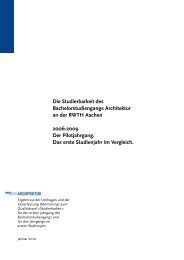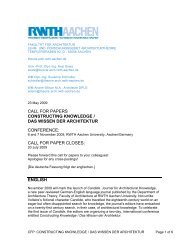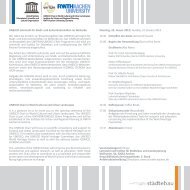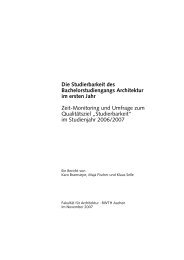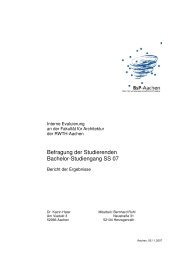Gutachten Dresden_englisch_dritte f.indd - Fakultät für Architektur ...
Gutachten Dresden_englisch_dritte f.indd - Fakultät für Architektur ...
Gutachten Dresden_englisch_dritte f.indd - Fakultät für Architektur ...
Create successful ePaper yourself
Turn your PDF publications into a flip-book with our unique Google optimized e-Paper software.
would no longer exist at various locations. It would visually cut the Elbe river bend in<br />
two.<br />
This effect is especially clear from vantage points at the apex of the Elbe river bend.<br />
These viewing points illustrate the spatial coherence of the Elbe bend in a special<br />
manner because it is possible from there to look into both the eastern and western sides<br />
of the valley. The planned bridge structure, however, would cause the valley to visually<br />
fall into two parts, greatly changing its landscape quality.<br />
From other viewing points, different visual effects are produced. The visual impact<br />
diminishes as the viewer proceeds to the east or the west of the study area. So, for<br />
instance, almost no visual impact results from the planned thoroughfare when viewed<br />
from the lookout points at the hill station of the suspension cable railway at Loschwitz<br />
or the dome of the Frauenkirche. This is a result of the greater distance from the apex<br />
of the Elbe valley bend. From other viewing points nearer to the apex, the impairment<br />
is greater. The original panoramic composition from the Saloppe waterworks lookout<br />
point for instance, must be regarded as totally devalued because, from that location,<br />
<strong>Dresden</strong>’s silhouette is completely obscured.<br />
Generally panoramas from viewing locations at higher elevations, for instance the<br />
terrace at the Elbe castles, are less impaired by the planned construction since, from<br />
there, the valley can still be perceived in its total context. This is also partially true for<br />
the well known “Waldschlösschen view”. From this position, the view of <strong>Dresden</strong>’s<br />
skyline above the Waldschlösschen Bridge would still be possible. From there, however,<br />
the Elbe meadows, which originally “framed” the city silhouette and are therefore an<br />
essential component of this panoramic view, are cut in two. This would greatly degrade<br />
this “classical” view of <strong>Dresden</strong>’s silhouette, familiar from paintings and photographs.<br />
Additional visual changes would occur around the north bridge head. It has been a<br />
characteristic of this landscape until now, that the Elbe meadows have extended up to<br />
Bautzner Strasse. This allowed, on the one hand, a connection between the “Prussian<br />
Quarter“ and the Elbe floodplains and, on the other, an unimpaired view from the<br />
Elbe valley towards the Waldschlösschen brewery. As a result of the extension of the<br />
planned bridge head at this location, a considerable part of the Elbe meadows, which<br />
up to now have been left open, would be built over, thereby changing the characteristic<br />
local morphology of the Elbe meadowland.<br />
Similarly, the area of Stauffenbergallee would be greatly affected by the planned trough<br />
structure, significantly changing the character of the street. This measure, however,<br />
affects an area beyond the UNESCO protected zones.<br />
106





